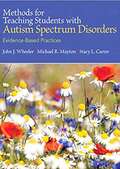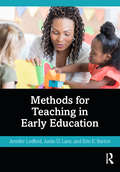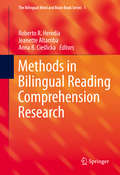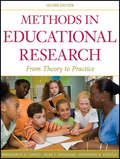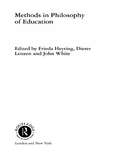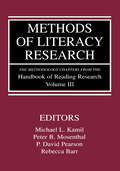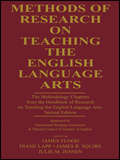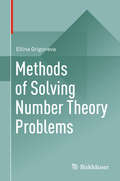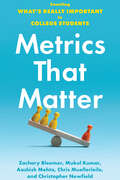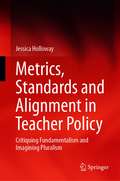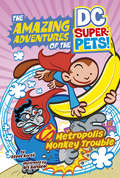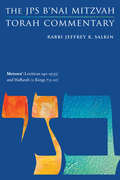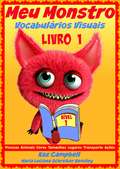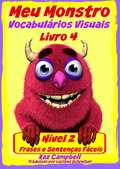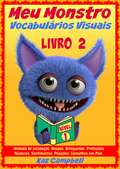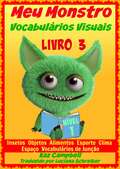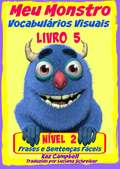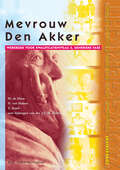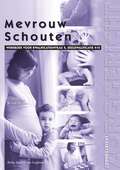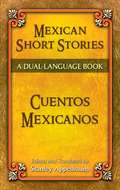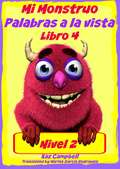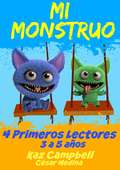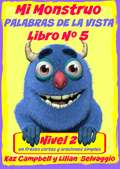- Table View
- List View
Methods for Teaching Students With Autism Spectrum Disorders: Evidence-Based Practices
by Stacy L. Carter John J. Wheeler Michael R. MaytonMethods for Teaching Students with Autism Spectrum Disorders is the most comprehensive text available, aimed at helping pre-service and in-service teachers and related service professionals understand the importance of evidence-based practices in the education of learners with Autism Spectrum Disorders (ASD) from a family and longitudinal learning perspective. <p><p>With its emphasis on the theme of family and professional partnerships and collaboration and consultation, the book includes learning aids such as suggested print and web-based resources, graphic organizers, and points for reflection; child and family vignettes, “Consider This” features, and examples of exemplary programs and practices; and the most up-to-date information and latest trends in the field.
Methods for Teaching in Early Education: Contexts for Inclusive Classrooms
by Erin E. Barton Jennifer Ledford Justin D. LaneMethods for Teaching in Early Education is a comprehensive textbook offering a thorough introduction to early childhood teaching methods, with a particular focus on inclusive practices. Aligned with both NAEYC standards and CEC’s Division for Early Childhood recommended practices, this text explores various early childhood teaching principles and strategies, providing useful guidance for identifying and choosing between approaches. Covering topics from child-directed strategies to working with professionals in early childhood, the authors provide extensive support to prepare teachers for classroom planning and instruction. Each chapter opens and closes with representative vignettes of the challenges faced by today’s early educators, and helpfully highlights key terms and objectives to inform learning goals. With the addition of sample worksheets, suggested exercises and helpful references, this book fully supports future teachers in understanding how they might implement these strategies in practice. Methods for Teaching in Early Education will prove indispensable for students of teaching methods courses in both general and special education programs, providing a comprehensive introduction to early childhood teaching strategies relevant for today’s inclusive classrooms.
Methods in Bilingual Reading Comprehension Research
by Jeanette Altarriba Roberto R. Heredia Anna B. CieślickaThe collected essays in this volume present an overview and state-of-the-field of traditional and recently developed methodological approaches to the study of bilingual reading comprehension. It critically reviews and examines major findings from classical behavioral approaches such as the visual moving window, rapid-serial visual presentation (RSVP), and eye-tracking, as well as newly developing neuropsycholinguistic methodologies such as Event-Related Potentials (ERPS), and Functional Magnetic Resonance Imaging (fMRI). Written to address a timely topic, Methods in Bilingual Reading Comprehension Research updates the field of bilingual reading by critically examining the contributions of the various behavioral and technologically-based reading techniques used to understand psychological processes underlying written language comprehension. Each topic is covered first from a theoretical, and then from an experimental, viewpoint. Moreover, the volume contributes to the development and establishment of Bilingual Reading as a subfield of bilingual sentence processing and fills a significant gap in the literature on bilingual language processing and thought. Significantly, Methods in Bilingual Reading Comprehension Research presents an overall view of some of the typical psycholinguistic techniques and approaches, as well as proposing other possible tasks that may prove viable in investigating such theoretical issues as bilingual lexical ambiguity resolution, or how bilingual speakers might resolve multiple sources of potentially conflicting information as they comprehend sentences and discourse during the communicative process. In addition, to aid reader comprehension and encourage readers to acquire "hands on" experience in the creation and development of experiments in the realm of bilingual reading research, each chapter includes a list of key words, suggested student research projects, and questions to both help the reader review the chapter and expand upon the reading. With its comprehensive coverage of a crucial subfield of psycholinguistics and language processing, Methods in Bilingual Reading Comprehension Research is an invaluable and informative resource for all students and researchers in bilingualism, neurolinguistics, bilingual cognition, and other related fields.
Methods in Educational Research
by Dean T. Spaulding Katherine H. Voegtle Marguerite G. LodicoMethods in Educational ResearchMethods in Educational Research is designed to prepare students for the real world of educational research. It focuses on scientifically-based methods, school accountability, and the professional demands of the twenty-first century, empowering researchers to take an active role in conducting research in their classrooms, districts, and the greater educational community. Like the first edition, this edition helps students, educators, and researchers develop a broad and deep understanding of research methodologies. It includes substantial new content on the impact of No Child Left Behind legislation, school reform, quantitative and qualitative methodologies, logic modeling, action research, and other areas. Special features to assist the teaching and learning processes include vignettes illustrating research tied to practice, suggested readings at the end of each chapter, and discussion questions to reinforce chapter content.Praise for the Previous Edition"A new attempt to make this subject more relevant and appealing to students. Most striking is how useful this book is because it is really grounded in educational research. It is very well written and quite relevant for educational researchers or for the student hoping to become one." -PsycCRITIQUES/American Psychological Association"I applaud the authors for their attempt to cover a wide range of material. The straightforward language of the book helps make the material understandable for readers." -Journal of MultiDisciplinary Evaluation
Methods in Philosophy of Education (Routledge International Studies in the Philosophy of Education #Vol. 13)
by John White Dieter Lenzen Frieda HeytingThis important new book presents a 'dual strand' argument: Firstly, it gives a comprehensive account of methods in philosophy of education, with leading international figures in the field of writing from a variety of methodological and epistemological perspectives. Secondly, it examines their application in the 'real world' of education, using the topical area of children's rights as a basis for investigation. It will therefore be of interest to philosophers and educationalists alike.
Methods of Literacy Research: The Methodology Chapters From the Handbook of Reading Research, Volume III
by P. David Pearson Michael L. Kamil Peter B. Mosenthal Rebecca BarrIn this volume, 10 reviews of significant reading research methodologies are reprinted from the Handbook of Reading Research, Volume III. The editors have judged that these specific methodologies have had great impact on reading research since the publication of Volume II in 1991. This text is especially well-suited for use in upper-level undergraduate and graduate-level reading research methods courses.
Methods of Research on Teaching the English Language Arts: The Methodology Chapters From the Handbook of Research on Teaching the English Language Arts, Sponsored by International Reading Association & National Council of Teachers of English
by James Flood Diane Lapp James R. Squire Julie M. JensenThis text makes available in a concise format the chapters comprising the research methodology section of the Handbook of Research on Teaching the English Language Arts, Second Edition. An introduction, designed to give K-12 teachers an understanding of the basic categories and functions of research in teaching, is followed by chapters addressing teacher professionalism and the rise of "multiple literacies"; empirical research; longitudinal studies; case studies; ethnography; teacher research; teacher inquiry into literacy, social justice, and power; synthesis research; fictive representation; and contemporary methodological issues and future direction in research on the teaching of English. Methods of Research on Teaching the English Language Arts is well-suited for use in upper-level undergraduate and graduate-level literacy research methods courses.
Methods of Solving Number Theory Problems
by Ellina GrigorievaThrough its engaging and unusual problems, this book demonstrates methods of reasoning necessary for learning number theory. Every technique is followed by problems (as well as detailed hints and solutions) that apply theorems immediately, so readers can solve a variety of abstract problems in a systematic, creative manner. New solutions often require the ingenious use of earlier mathematical concepts - not the memorization of formulas and facts. Questions also often permit experimental numeric validation or visual interpretation to encourage the combined use of deductive and intuitive thinking. The first chapter starts with simple topics like even and odd numbers, divisibility, and prime numbers and helps the reader to solve quite complex, Olympiad-type problems right away. It also covers properties of the perfect, amicable, and figurate numbers and introduces congruence. The next chapter begins with the Euclidean algorithm, explores the representations of integer numbers in different bases, and examines continued fractions, quadratic irrationalities, and the Lagrange Theorem. The last section of Chapter Two is an exploration of different methods of proofs. The third chapter is dedicated to solving Diophantine linear and nonlinear equations and includes different methods of solving Fermat’s (Pell’s) equations. It also covers Fermat’s factorization techniques and methods of solving challenging problems involving exponent and factorials. Chapter Four reviews the Pythagorean triple and quadruple and emphasizes their connection with geometry, trigonometry, algebraic geometry, and stereographic projection. A special case of Waring’s problem as a representation of a number by the sum of the squares or cubes of other numbers is covered, as well as quadratic residuals, Legendre and Jacobi symbols, and interesting word problems related to the properties of numbers. Appendices provide a historic overview of number theory and its main developments from the ancient cultures in Greece, Babylon, and Egypt to the modern day. Drawing from cases collected by an accomplished female mathematician, Methods in Solving Number Theory Problems is designed as a self-study guide or supplementary textbook for a one-semester course in introductory number theory. It can also be used to prepare for mathematical Olympiads. Elementary algebra, arithmetic and some calculus knowledge are the only prerequisites. Number theory gives precise proofs and theorems of an irreproachable rigor and sharpens analytical thinking, which makes this book perfect for anyone looking to build their mathematical confidence.
Metrics That Matter: Counting What's Really Important to College Students
by Mukul Kumar Christopher Newfield Zachary Bleemer Aashish Mehta Chris MuellerleileColleges sell themselves by the numbers—rankings, returns on investments, and top-ten lists—but these often mislead prospective students. What numbers should they really be paying attention to?High school and college students are inundated by indicators and rankings supposedly designed to help them decide where to go to college and what to study once they arrive. In Metrics That Matter, coauthors Zachary Bleemer, Mukul Kumar, Aashish Mehta, Chris Muellerleile, and Christopher Newfield take a critical look at these metrics and find that many of the most popular ones are confusing, misleading, and—most importantly—easily replaceable by more helpful alternatives. Metrics That Matter explores popular metrics used by future and current college students, with chapters focusing on colleges' return on investment, university rankings, average student debt, average wages by college major, and more. Written for students, their families, and the counselors who advise them, each chapter explains a common metric's fundamental flaws when used as a basis for making important educational decisions. The authors then draw on decades of scholarship from many academic fields to pair each metric with a concrete recommendation for alternative information, both qualitative and quantitative, that would be more useful and meaningful for students to consider. They emphasize that students should be thinking beyond solely using metrics when making college decisions—students should focus on their intellectual and academic education goals, not just vocational or monetary ones.Students' reliance on certain metrics has skewed universities away from providing high-quality education and distorted the perception of higher education's purpose, overemphasizing private financial returns over the broader economic and social benefits of universities. This book aims to facilitate important student decisions while reorienting public perceptions of higher education's values and how universities should measure their own success.
Metrics, Standards and Alignment in Teacher Policy: Critiquing Fundamentalism and Imagining Pluralism
by Jessica HollowayThis book looks at the narrowing effects of contemporary modes of teacher and teaching policy and governance. It draws on political theory to provide new ways of conceptualising the effects of teacher and teaching policies and practices. It adds a new dimension to the robust body of literature related to teacher policy by looking at three interrelated domains: (1) teacher preparation and development, (2) teacher evaluation and (3) teacher leadership.Drawing from case studies from the USA, UK and Australia, it illustrates how a coalescence around metrics, standards and compliance is producing increasingly restricted notions of teachers and teaching. It shows how the rationalities and techniques associated with accountability and standardisation are limiting the possibilities for multiple conceptualisations of teaching and teachers to exist or emerge. Using pluralism as the main framework, it challenges the dangers associated with rigid compliance and alignment and argues that pluralism can help secure schools as socially and culturally responsive to the needs of the community.
Metropolis Monkey Trouble (The Amazing Adventures of the DC Super-Pets)
by Steve KorteA chunk of Kryptonite has turned Superman into a wild animal! He’s on the streets and looking to make monkey trouble. Can Beppo the Super-Monkey stop him from making Metropolis his playground?
Metsi A Mokgakwana: UBC contracted
by Ka Mosala W. HumaMetsi A Mokgakwana Setswana Poetry Grade 11 prescribed literature CAPS
Metsi A Mokgakwana: UBC uncontracted
by Ka Mosala W. HumaMetsi A Mokgakwana Setswana Poetry Grade 11 prescribed literature CAPS
Metsora' (Leviticus 14 (Leviticus 14 (Leviticus 14 (Leviticus 14:1-15:33) and Haftarah (2 Kings 7:3-20): The JPS B'nai Mitzvah Torah Commentary
by Rabbi Jeffrey K. SalkinMetsora' (Leviticus 14:1-15:33) and Haftarah (2 Kings 7:3-20): The JPS B’nai Mitzvah Torah Commentary shows teens in their own language how Torah addresses the issues in their world. The conversational tone is inviting and dignified, concise and substantial, direct and informative. Each pamphlet includes a general introduction, two model divrei Torah on the weekly Torah portion, and one model davar Torah on the weekly Haftarah portion. Jewish learning—for young people and adults—will never be the same. The complete set of weekly portions is available in Rabbi Jeffrey K. Salkin’s book The JPS B’nai Mitzvah Torah Commentary (JPS, 2017).
Meu Monstro - Vocabulários Visuais - Nível 1 - Livro 1
by Kaz Campbell Luciana SchreiberUm livro de VOCABULÁRIOS VISUAIS para Aprender a Ler destinado a Pequenos Leitores. O Livro 1 contém mais de 100 páginas com figuras coloridas e interessantes de Pessoas, Animais, Cores, Tamanhos, Lugares, Transporte e Ações e suas palavras correspondentes. Este é o Primeiro Livro da Série Meu Monstro Aprender a Ler. Trabalhe com esta série de livros e você será capaz de ensinar sua criança a ler e oferecê-la uma grande vantagem inicial. Existem 3 livros de Vocabulários Visuais no Nível 1 (palavras isoladas e figuras) e cada um cobre 7 áreas diferentes. Os livros da série Aprenda a Ler são todos numerados, então comece pelo Livro 1 e continue trabalhando nos próximos. Os livros do Nível 2 (existem também 3 livros neste nível) também contêm Vocabulários Visuais, mas ao invés de palavras isoladas, elas são combinadas com frases curtas e sentenças simples. Uma figura acompanha cada frase ou sentença…facilitando a leitura para sua criança. Os livros do Nível 3 avançam para os Sons do Alfabeto, Fonética e Vocabulários de Família. Os livros do Nível 4 são um pouco mais avançados e apropriados para crianças que têm algumas habilidades básicas de leitura. Se elas tiverem progresso ao longo dos primeiros nove livros da série Meu Monstro...então elas poderão se preparar para o Nível 4, Leitores Iniciantes. Os livros do Nível 5 são livros de pequenos capítulos que manterão sua criança entretida com histórias divertidas sobre monstrinhos bonitinhos e amigáveis. Você também pode ler estes livros para crianças de 4 anos em diante. A série O Meu Monstro Aprende a Ler é o caminho perfeito para ensinar sua criança a ler. Este livro também possui uma vários de conselhos aos pais para auxiliá-los no ensinamento da leitura aos seus filhos.
Meu Monstro - Vocabulário Visual - Nível 2 - Livro 4
by Kaz Campbell Luciana SchreiberAprenda a Ler VOCABULÁRIOS VISUAIS Nível 2 Livro 4 para Leitores Iniciantes. O livro 4 combina os vocabulários visuais cobertos no Meu Monstro Nível 1 - Livros 1, 2 e 3 com frases curtas e sentenças simples. Cada página é acompanhada de uma figura para tornar a leitura mais fácil para a criança. Trabalhe nesta série de livros e você será capaz de ensinar sua criança a ler e dará a elas uma vantagem inicial
Meu Monstro - Vocabulários Visuais - Nível 1 - Livro 2
by Kaz Campbell Luciana SchreiberAprenda a Ler, VOCABULÁRIOS VISUAIS, Livro 2 para Leitores Iniciantes. O Livro 2 contem mais de 100 páginas com figuras coloridas e interessantes de Animais de Estimação, Roupas, Brinquedos, Profissões, Números, Sentimentos, Posições e seus vocabulários correspondentes. Este é o 2o Livro da Série Meu Monstro Aprende a Ler. Trabalhe nesta série de livros e você será capaz de ensinar sua criança a ler e dará a ela uma vantagem inicial. Existem 3 Livros de Vocabulários Visuais no Nível 1 (palavras isoladas e figuras) e cada livro cobre 7 áreas diferentes. Os livros da série Aprenda a Ler são todos numerados, portanto inicie com o Livro 1 e continue trabalhando nos próximos. Os livros do Nível 2 (também existem 3 livros deste nível) também contêm Vocabulários Visuais, mas ao invés de palavras isoladas, estas são combinadas com pequenas frases e sentenças simples. Uma figura acompanha cada frase ou sentença...facilitando a leitura para sua criança.
Meu Monstro - Vocabulários Visuais - Nível 1 - Livro 3
by Kaz Campbell Luciana SchreiberAprenda a Ler, VOCABULÁRIOS VISUAIS, Livro 3 para Pequenos Leitores. O Livro 3 contem mais de 100 páginas com figuras coloridas e interessantes de insetos, objetos, comida, esportes, clima, espaço, palavras de junção e suas correspondentes. Este é o 3o Livro da Série Meu Monstro Aprende a Ler. Trabalhe nesta série de livros e você será capaz de ensinar sua criança a ler e dar a ela uma vantagem inicial. Existem 3 Livros de Vocabulários Visuais no Nível 1 (palavras isoladas e figuras) e cada livro cobre 7 áreas diferentes. Os livros da série Aprenda a Ler são todos numerados, portanto inicie com o Livro 1 e continue trabalhando nos próximos. Os livros do Nível 2 (também existem 3 livros deste nível) também contêm Vocabulários Visuais, mas ao invés de palavras isoladas, estas são combinadas com pequenas frases e sentenças simples. Uma figura acompanha cada frase ou sentença...facilitando a leitura para sua criança. A série O Meu Monstro Aprende a Ler é o caminho perfeito para ensinar sua criança a ler. Este livro também possui vários conselhos aos pais para auxiliá-los no ensinamento da leitura a sua criança.
Meu Monstro - Vocabulários Visuais - Nível 2 - Livro 5
by Kaz Campbell Luciana SchreiberAprenda a Ler VOCABULÁRIOS VISUAIS Nível 2 Livro 5 para Leitores Iniciantes. O livro 5 combina os vocabulários visuais cobertos no Meu Monstro Nível 1 - Livros 1, 2 e 3 com frases curtas e sentenças simples. Cada página é acompanhada de uma figura para tornar mais fácil a leitura para as crianças. Trabalhe nesta série de livros e você será capaz de ensinar sua criança a ler e dará a elas uma vantagem inicial. start. Existem 6 livros de Vocabulários Visuais no Programa Aprenda a Ler. No Nível 1 (palavras isoladas e figuras) existem três livros e o Nível 2 (combina os vocabulários visuais com sentenças simples) também possui três livros. Os livros da série Aprenda a Ler são todos numerados, portanto inicie com o Livro 1 e continue trabalhando nos próximos.
Mevrouw Den Akker
by Y. Smid M. De Haan N. Van HalemHoofdpersoon in de casus is mevrouw Den Akker. Een oudere dame, die na een leven met haar echtgenoot, haar werk, de zorg voor de kinderen en allerlei activiteiten in de samenleving, nu in allerlei opzichten achteruit gaat en verzorgd moet worden. Een dame die je in menig verzorgingshuis zou kunnen tegenkomen. De specifieke zorg voor mevrouw Den Akker op het gebied van voeding en uitscheiding heeft in deze casus met het clusterthema "voeding en uitscheiding" speciaal de aandacht.
Mevrouw Schouten
by Nicolien Van Halem C. OttenZorgcategorie: Kraamvrouw Setting: KraamafdelingKorte inhoud: Bij de meeste vrouwen verlopen de zwangerschap, de bevalling en de kraamperiode zonder problemen, maar niet bij alle. Hanneke Schouten is zo'n vrouw. In de loop van de zwangerschap moet zij steeds meer rekening houden met gezondheidsproblemen. Een geplande thuisbevalling wordt verplaatst naar het ziekenhuis en ook de bevalling en de eerste uren daarna verlopen niet zonder problemen. Hierdoor is ook het kraambed anders en op een andere locatie dan Hanneke en haar man van tevoren bedacht hadden.
Mexican Short Stories / Cuentos mexicanos: A Dual-Language Book
by Stanley AppelbaumGreatly influenced by Europe's nineteenth-century literary trends, Mexico's writers crafted some of the most phenomenal prose fiction in Spanish America. This collection offers a rich sampling of significant Mexican short stories published from 1843 to 1918. Nine different tales range from the realism of López Portillo's "Reloj sin dueño" and the modernismo saturating Gutiérrez Nájera's "La mañana de San Juan" to the historical accuracy of Riva Palacio's "Las mulas de Su Excelencia" and the vivid romanticism of "Amor secreto" by Manuel Payno, named the "father of Mexican short stories." Each story appears in its original Spanish text with expert English translations on each facing page. This dual-language edition features a fascinating new introduction and ample footnotes. An easy-reading pleasure for lovers of fine Spanish-language literature, it is also a valuable educational aid for students and teachers.
Mi Monstruo - Nivel 2 Palabras a la vista - Libro 4
by Kaz Campbell Marina García RodríguezLibro de palabras a la vista para lectores principiantes, con frases cortas y oraciones sencillas Aprende a leer PALABRAS A LA VISTA, nivel 2, libro para lectores principiantes. El libro 4 combina las palabras a la vista que cubrimos en Mi Monstruo nivel 1 - Libros 1, 2 y 3 en frases cortas y oraciones sencillas. Cada página tiene una imagen de referencia para hacerle más fácil la lectura a los más pequeños. Trabaje a lo lago de esta serie de libros y será capaz de enseñarle a su hijo/a a leer y a darles un gran comienzo. Hay 6 libros de Palabras a la Vista en este Programa para aprender a leer. En el nivel 1 (palabras solas e imágenes), hay tres libros y el nivel 2 (incluye las palabras a la vista en oraciones sencillas) también tiene tres libros. Los libros en la serie de Aprender a leer están numerados, por lo que deberán comenzar con el libro uno y seguir a partir de ahí. La serie de Mi Montruo aprende a leer es el método perfecto para enseñarle a tu hijo/a a leer. Este libro también incluye varios consejos de lectura para ayudar a+ padres y a niños.
Mi Monstruo 4 Primeros Lectores
by Kaz Campbell César Medina CruzSigue las aventuras de los monstruos en su primer día en el Cole; en el parque; yendo al truco o trato y también lee acerca de la fiesta de cumpleaños. Todas las historias tienen imagenes para ayudar la comprensión y el disfrute de la lectura de tu hijo. Hay 2 secciones extra: bromas monstruosas, toc toc chistes, trabalenguas. También una sección que explica Cómo Leer con un Niño Pequeño.
Mi Monstruo PALABRAS DE LA VISTA Nivel 2 Libro Nº 5
by Kaz Campbell Lilian G. SelvaggioAprende a Leer PALABRAS DE LA VISTA Nivel 2, Libro Nº 5, para Lectores iniciales. El libro Nº 5 combina las palabras de la vista cubiertas en Mi Monstruo Nivel 1-Libros Nº 1, 2 y 3 en frases cortas y oraciones simples. Cada página está ilustrada, haciendo la lectura más fácil para los niños. Al trabajar con esta serie de libros podrás enseñar a tu hijo a leer y le darás un importante envión inicial. Hay 6 libros de Palabras de la Vista en este Programa para Aprender a Leer. En el Nivel 1 (palabras simples e imágenes) hay tres libros, y en el Nivel 2 (que combina las palabras de la vista en oraciones simples) hay también tres libros. Los libros de la serie están enumerados, por lo tanto puedes comenzar desde el Libro Nº 1 y continuar trabajando con los siguientes.
